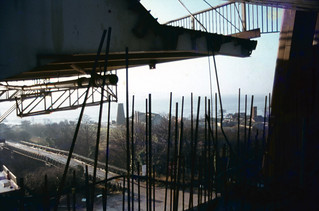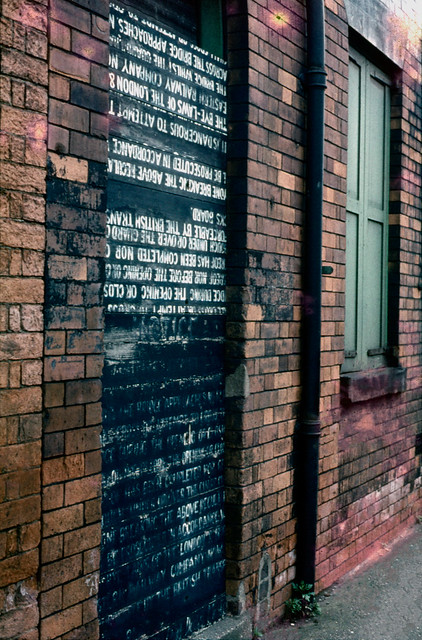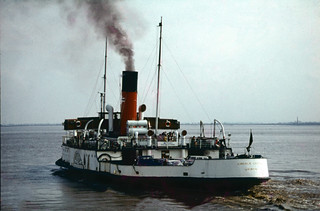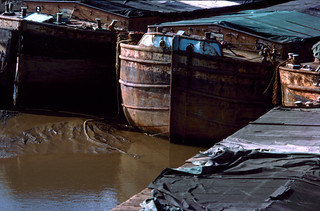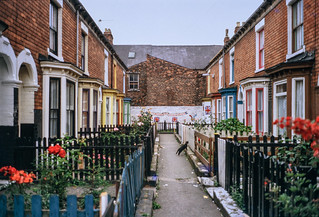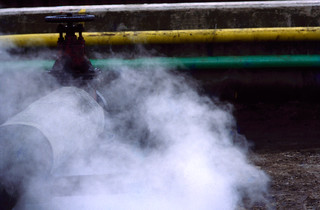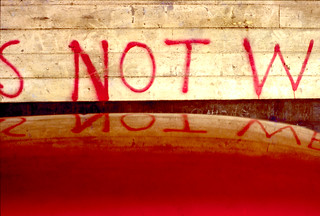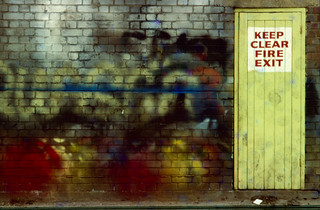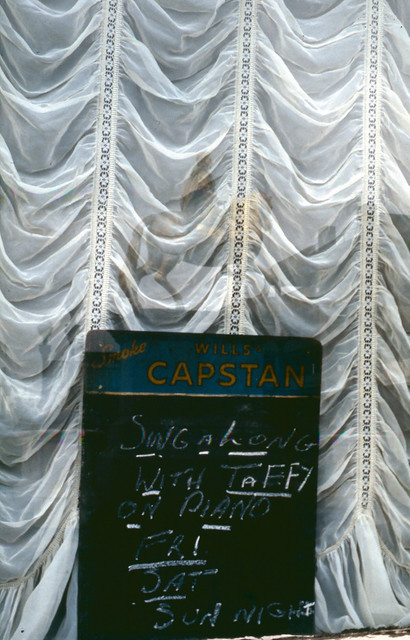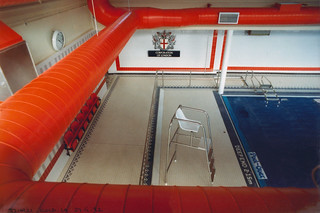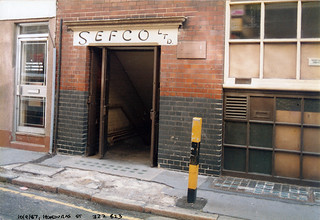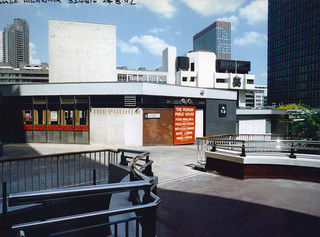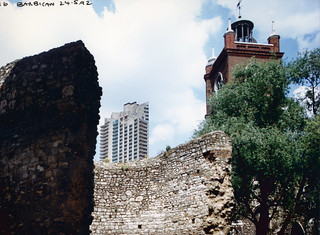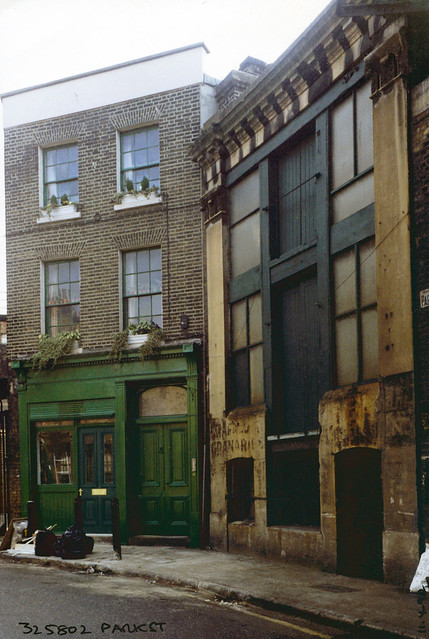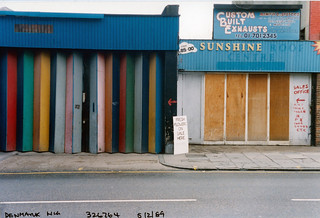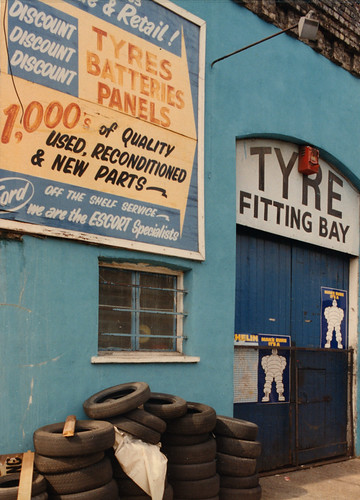I’m not sure from exactly where I took this view of the Humber Bridge under construction, but I was fortunate enough to go on a tour of the construction organised for a group of science teachers, and it could have been made during that visit, though I don’t remember taking any colour pictures then. The bridge took around 9 years to build and was completed and opened in 1981.
The mill visible on Hessle foreshore was built around 1810 to grind the chalk that was being quarried here into whiting, finely powdered chalk used as a filler in paint and, together with linseed oil to make putty, in whitewash, gesso and ceramic glazes etc. The windmill went out of use about a hundred years ago, losing its cap and sails and the quarry closed in 1970. The area is now a country park.
After the cables were spun the box-girder sections of bridge decking were added, beginning in November 1979 and this picture must have been made shortly after this. Wikipedia states “the Humber Bridge was the longest single-span suspension bridge in the world for 17 years.”
When our family was travelling to Hull by train in the 1980s we would look out for the Humber Bridge in the distance to know we were getting close to our destination. I always offered a small cash prize for the first of our party to spot it through the train window, but think I never had to pay it out as I always saw it before the others.
The Humber has always seemed more mud in motion than a river, always a dirty brown colour, and it is only the small waves that differentiate between the river and the shore in this view. The mud and sandbanks in the estuary are always moving, and for many years ships travelling up the river to Hull or Goole needed the services of the Trinity House pilots, who started offering their services in 1512 and in 1581 were granted a charter authorising them to examine and licence pilots and take charge of ships. Various Acts of Parliament followed to endorse and regulate their activities, but the 1984 Pilotage Act transferred responsibility to the ports. In 2002 Associated British Ports terminated the authorisations of all Humber Pilots and employed their own pilots directly.
You can now walk along an esplanade along what had been the river frontage of Victoria Dock and various ship-building and other related businesses but only as far as what was the Alexandra Dock and is now ‘Green Port Hull’, a a wind energy manufacturing plant and riverside quay. I think this picture was probably taken just a little further downriver than the path now takes you.
There were some blue sheds on the dock side of Humber Dock that were demolished when the dock was dredged and converted into Hull Marina, and these had painted steel columns and wooden sides. The marine air had over the years produced this incredible rusting, lifting up the thick painted layers.
The buildings at the right of the picture are still there, though considerably altered on Humber Place at its junction with Wellington St, and are now Francis House, the offices of an accountancy firm, though the Wellington St building at extreme right has been demolished.
Although Hull lost some of its most impressive warehouses to a road scheme which split the Old Town from the city centre to take the heavy traffic for the King George Dock to the east of the city, some of those beside Railway Dock were retained, with the three gables shown here still visible, though the mass at the extreme right has been demolished.
King Billy, King William III or William of Orange, successfully invaded Britain in 1688 in what is sometimes called the ‘Glorious Revolution’. James II was unpopular, largely because he was a Catholic and was seen to be changing Britain to a Catholic country, suspending anti-Catholic measures by decree when Parliament refused to do so and prosecuting Anglican bishops for seditious libel. His actions prompted anti-Catholic riots and many leading political figures of the day invited William to come and take over the country. But there were also leading Catholic members of the aristocracy who defended James and the ‘divine right of kings’ to overule all others, including Parliament. One of them was the governor of Hull, Lord Langdale, who took the military to occupy the city of Hull, fearing that William of Orange might try and land there. But instead of coming across the North Sea, William’s fleet went down the Channel and landed at Brixham on Novermber 5th, marching from there to London. The army deserted James and he fled to France on December 11th.
Hull had remained under Catholic control until December 3rd, when Protestant officers, hearing of a plot to imprison them, got together and arrested Langdale and his Catholic supporters. The day was celebrated in Hull for many years as ‘Town Taking Day’ when many wore orange sashes and celebrated with a procession, church service and fireworks in the Market Square – and around the statue of King Billy after it had been erected there in 1734.
Market Place is very much a backwater in the Old Town now, on the edge of the busy A63 and with one side occupied by some of the city’s most tedious buildings, as well as the rear end of Holy Trinity. Since the listed public toilets under King Billy closed there are few reasons to go there.
A dockside building with a doorway closed with boards from a notice that was once beside one of the swing bridges, probably that taking Wellington St across the Humber Dock lock, warning people it is an offence to pass the warning lights onto the bridge or be on it while it is moving.
A public footpath crosses the swing bridge into Albert Dock, and some time in the early 1980s while I was out walking with my family I notice that my wife and younger son in a push-chair were no longer following me. I turned around an looked for them, eventually spotting them on the bridge which was turning around to admit a ship to the dock. They had walked past the warning lights before they had been activated and the bridge operator, do doubt thinking only of the lorries which went across, had failed to spot a young woman already on the bridge with a baby buggy. She got a free ride and profuse apologies rather than a fine.
One of Hull’s minor tourist attractions, perhaps inspired by notices such as these, is now a footbridge across the River Hull on which people are allowed to ride. Unfortunately ship movements up the Hull are now extremely rare and the bridge almost never operates in anger, but there are scheduled tests most if not all weekends on which I’ve taken a couple of rides.
All photographs on this and my other sites, unless otherwise stated, are taken by and copyright of Peter Marshall, and are available for reproduction or can be bought as prints.
